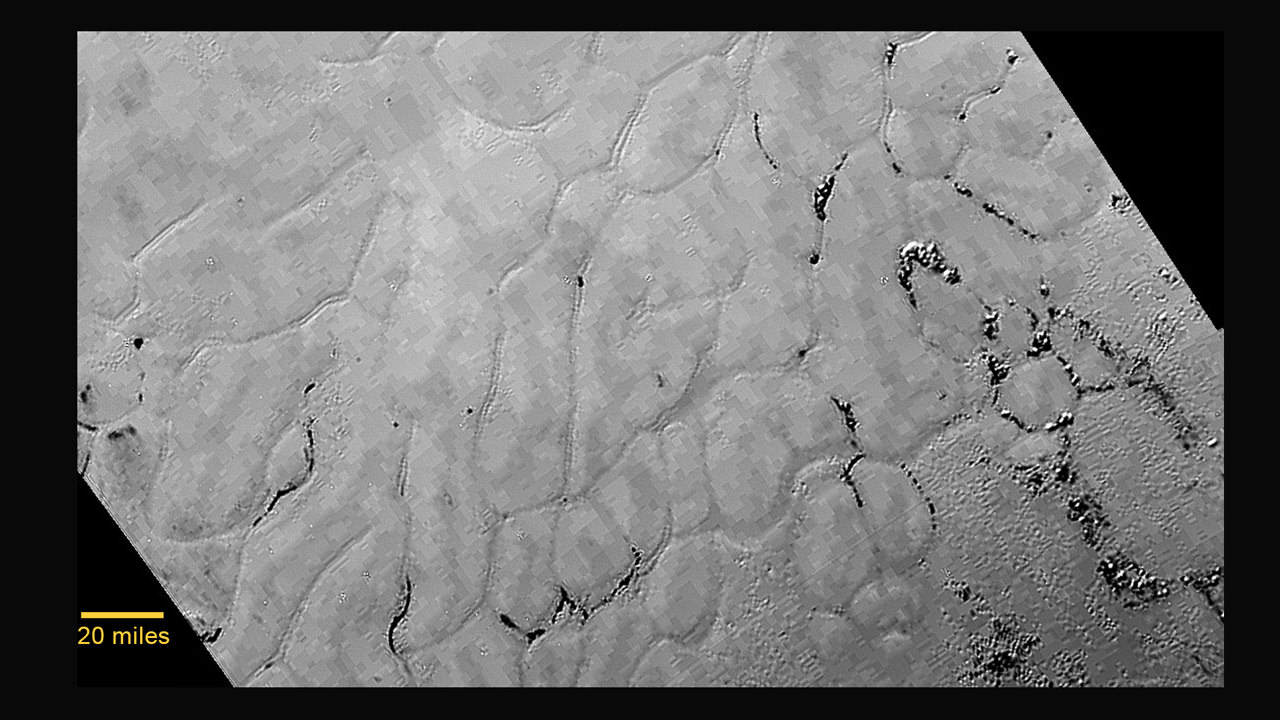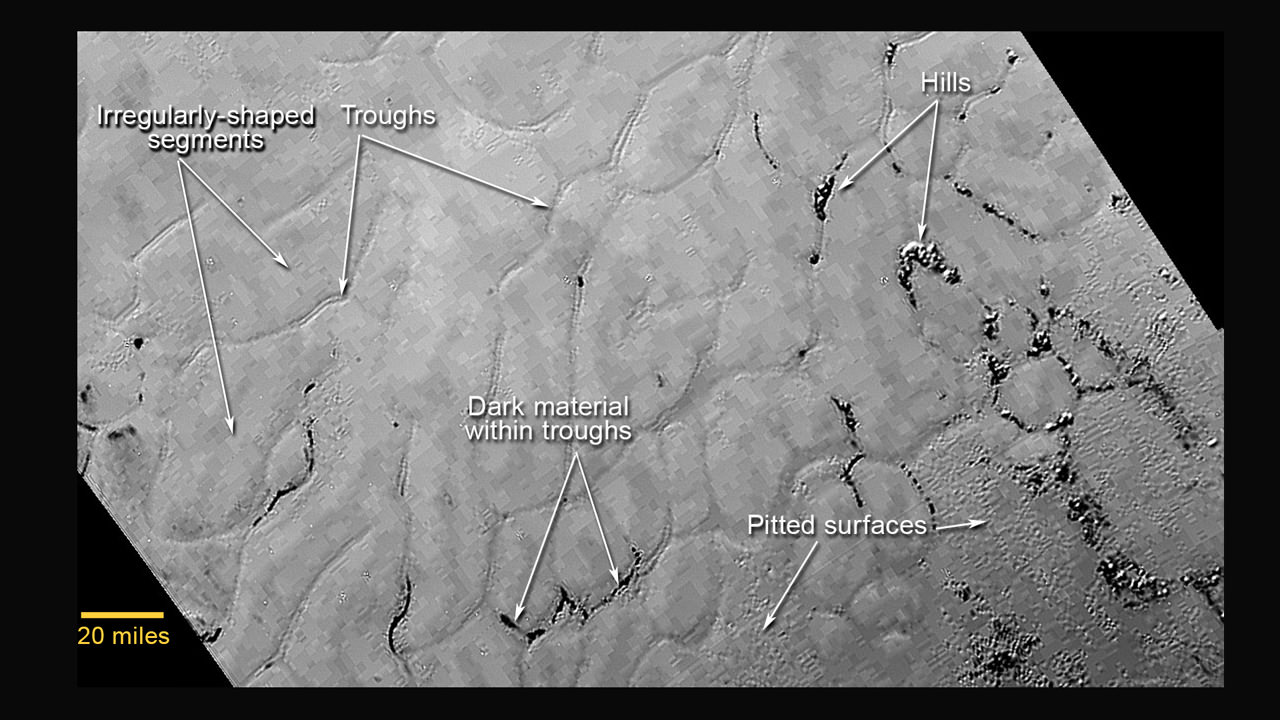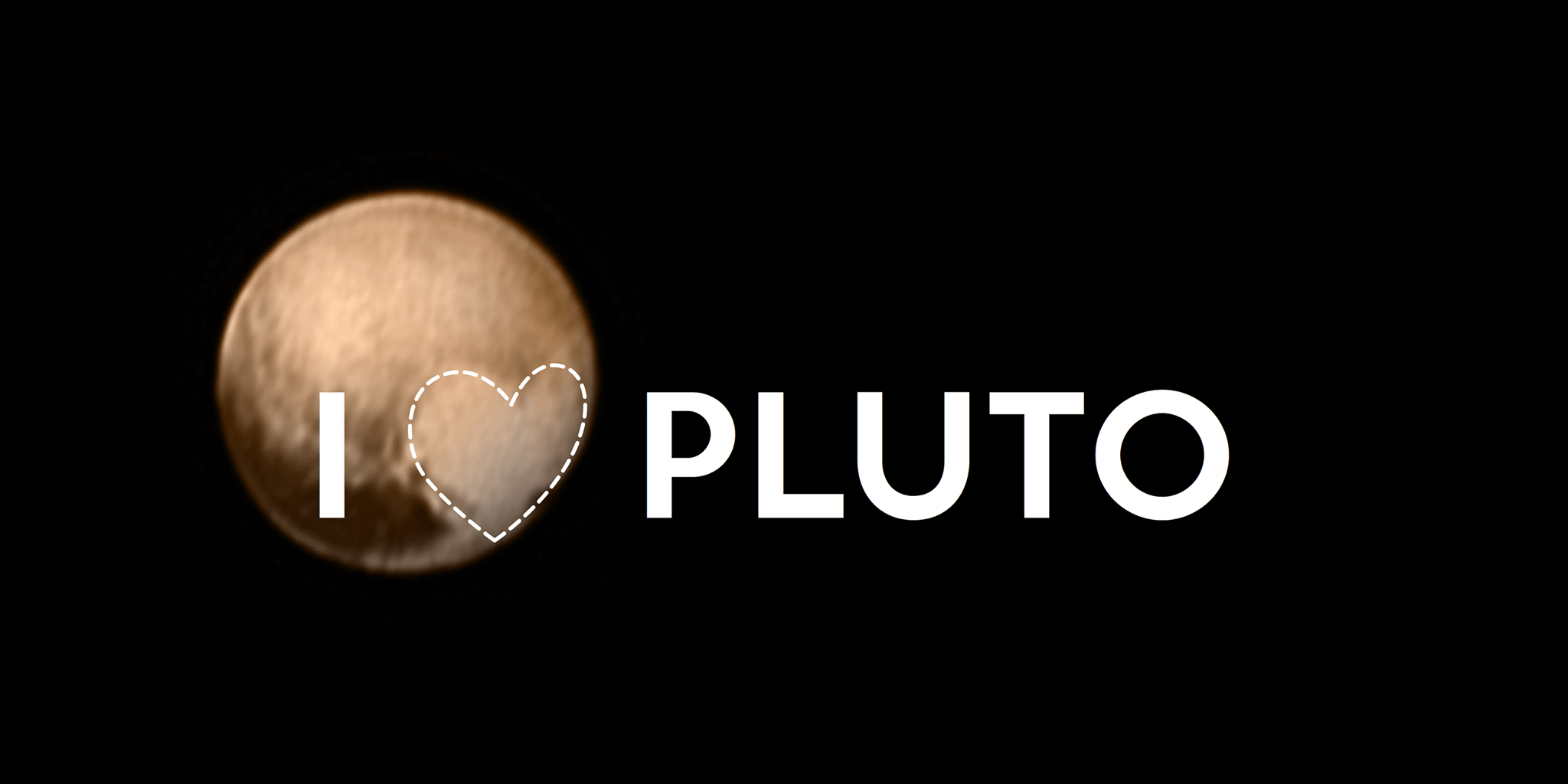This annotated view of a portion of Pluto’s Sputnik Planum (Sputnik Plain), named for Earth’s first artificial satellite, shows an array of enigmatic features. The surface appears to be divided into irregularly shaped segments that are ringed by narrow troughs, some of which contain darker materials. Features that appear to be groups of mounds and fields of small pits are also visible. This image was acquired by the Long Range Reconnaissance Imager (LORRI) on July 14 from a distance of 48,000 miles (77,000 kilometers). Features as small as a half-mile (1 kilometer) across are visible. Credits: NASA/JHUAPL/SWRI
See 3 image mosaic below[/caption]
A vast, hundreds of miles wide craterless plain of Plutonian ice no more than 100 million years old and centered amidst Pluto’s big ‘heart’ was unveiled in spectacular new imagery taken by NASA’s resounding successful New Horizons mission, during its history making rapid transit through the Pluto-Charon binary planet system barely three days ago, on Tuesday, July 14.
The jaw dropping new imagery of young plains of water ice was publicly released today, July 17, by NASA and scientists leading the New Horizons mission during a media briefing, and has already resulted in ground breaking new scientific discoveries at the last planet in our solar system to be visited by a spacecraft from Earth.
“We have now visited every planet in our solar system with American spacecraft,” said NASA Administrator Charles Bolden. “These findings are already causing us to rethink the dynamics of interior geologic processes.”
New data and dazzling imagery are now from streaming back some 3 billion miles across interplanetary space to mission control on Earth and researchers eagerly awaiting the fruits of more than two decades of hard labor to get to this once-in-a-lifetime opportunity.
“I can’t wait for the new discoveries!” exclaimed Bolden at today’s media briefing.
“Over 50 gigabits of data were collected during the encounter and flyby periods,” New Horizons principal investigator Alan Stern of the Southwest Research Institute, Boulder, Colorado, said during the media briefing.
“So far less than 1 gigabit of data has been returned.”
It will take some 16 months for all the Pluto flyby data to be transmitted back to Earth.
And the team has not been disappointed because the results so far shows Pluto to possess tremendously varied terrain that “far exceed our expectations.”
Video Caption: In the center left of Pluto’s vast heart-shaped feature – informally named “Tombaugh Regio” – lies a vast, craterless plain that appears to be no more than 100 million years old, and is possibly still being shaped by geologic processes. This frozen region is north of Pluto’s icy mountains and has been informally named Sputnik Planum (Sputnik Plain), after Earth’s first artificial satellite. Credits: NASA/JHUAPL/SWRI
Two new high resolution images captured by the probes Long Range Reconnaissance Imager (LORRI) on July 14 were released today and taken from a distance of 48,000 miles (77,000 kilometers). Features as small as one-half mile (1 kilometer) across are visible in the images – shown above and below.
They were snapped from frozen region lying north of Pluto’s icy mountains, in the center-left of the heart feature, informally named “Tombaugh Regio” (Tombaugh Region) after Clyde Tombaugh, who discovered Pluto in 1930.
“This terrain is not easy to explain,” said Jeff Moore, leader of the New Horizons Geology, Geophysics and Imaging Team (GGI) at NASA’s Ames Research Center in Moffett Field, California.
“The discovery of vast, craterless, very young plains on Pluto exceeds all pre-flyby expectations.”
“The landscape is astounding. There are a few ancient impact craters on Pluto. But other areas like “Tombaugh Regio” show no craters. The landform change processes are occurring into current geologic times.”
“There are no impact craters in a frozen area north of Pluto’s icy mountains we are now informally calling ‘Sputnik Planum’ after Earth’s first artificial satellite.”
‘Sputnik Planum’ is composed of a broken surface of irregularly-shaped segments. The polygonal shaped areas are roughly 12 miles (20 kilometers) across, bordered by what appear to be shallow troughs based on a quick look at the data.
Notably, some of the clumps are filled with mysterious darker material. Hills are also visible in some areas, which may have been pushed up. Etched areas on the surface may have been formed by sublimation process where the water ice turns directly from the solid to the gas phase due to the extremely negligible atmosphere pressure.
In some places there are also streaks that may have formed from windblown processes and pitted areas.
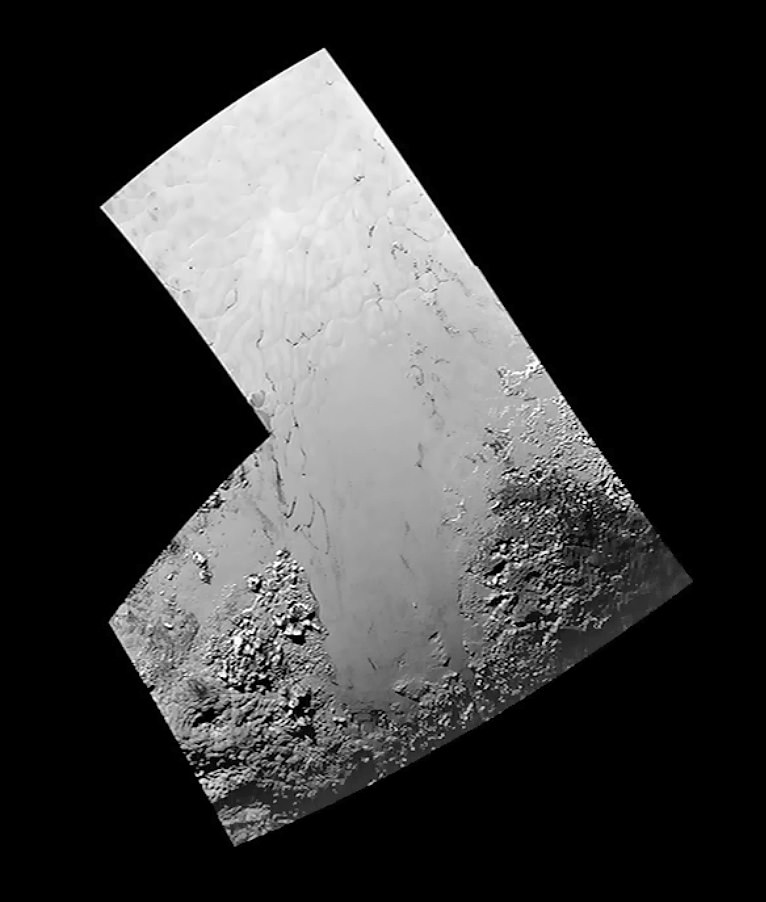
“It’s just pure coincidence that we got the highest resolution data at Sputnik Planum which is of the most interest scientifically,” Moore noted.
Moore indicated that the team is working on a pair of theories as to how these polygonal segments were formed.
“The irregular shapes may be the result of the contraction of surface materials, similar to what happens when mud dries. Alternatively, they may be a product of convection, similar to wax rising in a lava lamp. On Pluto, convection would occur within a surface layer of frozen carbon monoxide, methane and nitrogen, driven by the scant warmth of Pluto’s interior,” Moore explained.
Pluto’s polygons look remarkably similar to the Martian polygons upon which NASA’s Phoenix lander touched down on in 2008 and dug into. Perhaps they were formed by similar mechanisms or difference ones, contraction or convection, Moore told me during the briefing.
As of yesterday, New Horizons spacecraft completed and exited the Pluto encounter phase, said Stern. “We are now collecting departure science.”
New Horizons is already over 3 million miles beyond Pluto and heading to its next yet to be determined target in the Kuiper Belt.
“With the flyby in the rearview mirror, a decade-long journey to Pluto is over –but, the science payoff is only beginning,” said Jim Green, director of Planetary Science at NASA Headquarters in Washington.
“Data from New Horizons will continue to fuel discovery for years to come.”

Stay tuned here for Ken’s continuing Earth and planetary science and human spaceflight news.
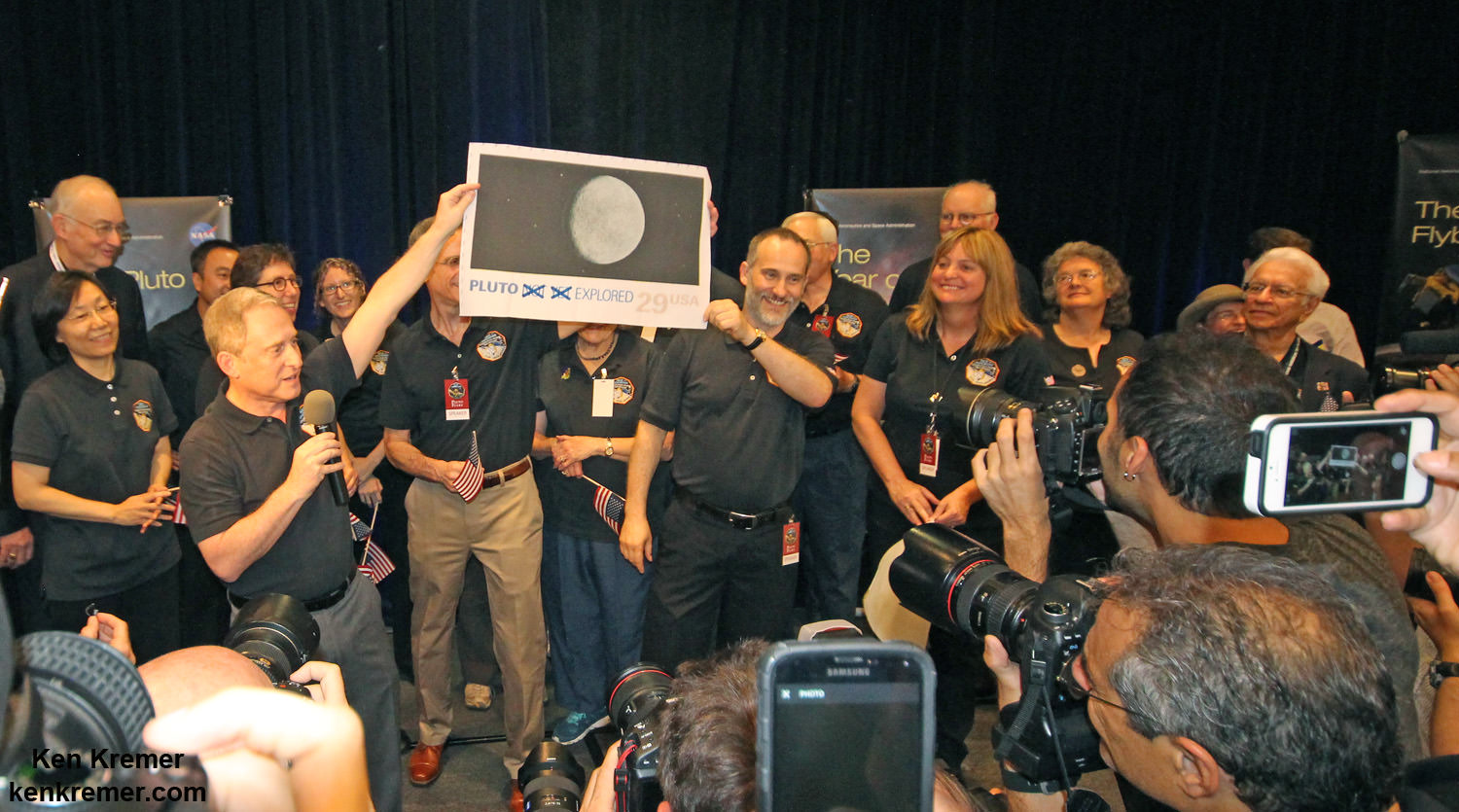
The New Horizons mission team celebrates successful flyby of Pluto in the moments after closest approach at 7:49 a.m. EDT on July 14, 2015. New Horizons Principal Investigator Alan Stern of Southwest Research Institute (SwRI), Boulder, CO., left, Johns Hopkins University Applied Physics Laboratory (APL) Director Ralph Semmel, center, and New Horizons Co-Investigator Will Grundy Lowell Observatory hold an enlarged print of an U.S. stamp with their suggested update after Pluto became the final planet in our solar system to be explored by an American space probe (crossing out the words ‘not yet’) – at the Johns Hopkins University Applied Physics Laboratory (APL) in Laurel, Maryland. Credit: Ken Kremer/kenkremer.com
